
Above: Osborne House seen as approaching the house entrance
The House
Osborne House is a former royal residence located on the Isle of Wight in the south of England. 'A place of one's own, quiet and retired' was what Queen Victoria sought and found here. The house was constructed for Queen Victoria and Prince Albert as a summer home and rural retreat away from the stresses of court life. Queen Victoria had spent two holidays on the Isle of Wight as a young girl; the setting of the estate appealed to herself and also to Prince Albert for whom the views of the Solent reminded him of the Bay of Naples in Italy. Built between 1845 and 1851, the new house, which replaced an existing smaller residence, was designed by Prince Albert himself in the style of an Italian Renaissance palazzo, complete with two belvedere towers. It was built by Thomas Cubitt, a London architect (whom was also responsible for building the main façade of Buckingham Palace in 1847), with Professor Grunner of Dresden advising on the interior decoration and gardens. Victoria and Albert paid for many of the furnishings from the sale of the Royal Pavilion at Brighton.

Above: Panoramic stitch photograph showing the rear of the house atop the terrace gardens (cylindrical projection)
The house and grounds provided Queen Victoria, Prince Albert and their children a place to enjoy the pleasures of family life by the seaside. They moved in during 1846 and from then on, Osborne continued to grow over the years, with further extensions being made to the house. It is here that Queen Victoria died in January 1901. The royal residence became surplus to the royal family's requirements and subsequently served for a while as a naval college. Today, it is under the care of English Heritage and is open to the public. Many of the magnificent paintings and Queen Victoria's belongings on show in the state and family rooms here respectively are still property of the Royal family; they are looked after on their behalf by the Royal Collection Trust.
The Interior
The thumbnail gallery above shows a selection of photos taken from inside the house. Here it is possible to view a number of opulently decorated state and private rooms where Queen Victoria entertained her important guests and where she lived with Prince Albert and their nine children. As with the house's architecture, the furnishings inside reflect their taste and style. Inside the state rooms, guests would have included Heads of state, other members of international royalty and inventors. Whilst Queen Victoria was here, Osborne was at the heart of the largest empire the world has ever known. A brief treatment of the main rooms which can be seen at Osborne, cross-referenced with the photos in the thumbnail gallery above, follows.
State Rooms
● The Council Room [Photos 16-19]. This room was
mostly used for entertaining, including dancing, drama and games of
charades. In this room, Alexander Graham Bell demonstrated his new
invention - the telephone - to the queen in 1878 and it is also here,
Prince Albert was given the title 'Prince Consort' by Queen Victoria.
The Privy Council occasionally met in this room and it also served as a
second dining room and ballroom. The Audience Room also on show was
where the ministers of the Privy Council gathered before their meetings
with the queen in the Council Room.
● The Dining Room [Photos 28-31].
Here it is possible to see the table laid for the queen's dinner.
● The
Drawing Room [Photos 34-39]. This room is decorated as much as possible
to show how it would have looked in the 1890's with it's chandeliers,
mirrors and yellow satin curtains. International royalty would have
often been received in this room and it is here the queen would have
generally retired after dinner for informal singing and playing the
piano, or to play cards.
● The Billiard Room [Photos 42-44]. A columned
screen and drawn curtains separate this room from the Drawing Room and
was where the men retired after dinner. The billiard table was designed
by Prince Albert. The Queen is also known to have played billiards
herself with the women of the household after lunch.
● The Durbar Room
[Photos 78, 79, 82-96]. This room is decorated with intricate
Indian-style plaster work, reflecting Queen Victoria’s then status as
Empress of India. It was designed by Bhai Ram Singh, a notable
architect, and J. Lockwood Kipling, father of Rudyard Kipling. Finished
in 1891 and built as part of an extension, this room has the most
elaborately decorated interior of the house with the plasterwork
covering every surface. It was used for ceremonial dinners for European
royalty and as the backdrop to theatrical entertainments favoured by the
queen. Many gifts that Victoria received as Empress of India are on
display here in cabinets. In the adjoining corridor can be seen a
collection of portraits of Indian rulers and subjects. The name 'Durbar'
comes from an Indian word which means both a state reception and the
hall where such gatherings took place.
Private Rooms
● The Royal The Nursery Suite [Photos 46-49].
This was situated above Queen Victoria and Prince Albert's private
apartments, allowing them easy access to their children. It included the
children's quarters, a schoolroom, a kitchen and the governess' rooms.
●
The Queen's Sitting Room [Photos 58-63]. This includes the balcony where
Victoria and Albert would listen to the birdsong on a summer's evening.
As with this room and subsequent rooms described here the Queen's
private suite of rooms have been left unaltered since she died.
● The
Queen's Dressing Room [Photos 64-66]. Here, it is possible to see the
queen's personal bath tub.
● The Queen's Bedroom [Photos 67-70]. It is
here Queen Victoria died on 22nd January 1901.
● Prince Albert's Private
Suite [Photos 53-57]. This room was maintained just how it was during
Albert's lifetime by Queen Victoria after he died on 14th December 1861.
● The Horn Room [Photo 74]. This was used as a sitting room for visitors
as they waited to meet the Queen. It is named so because most of the
furniture in it , is made of deer horn collected by Prince Albert and
Queen Victoria during their hunting at Balmoral in Scotland.
In addition to the rooms, also shown in the photos above are a selection of the corridors and passageways which are full of an extraordinary variety of gifts which Queen Victoria received from all over the world.
The Gardens and Grounds
Osborne has equally stunning gardens and grounds to complement the Italianate-style house and these extend right down to the sea. They offer an opportunity to discover the seasonal colours which are to be seen here throughout the year. The gardens offer a place to relax and highlights can include the tulips in spring and bedding displays in summer. Several historic trees sit in the parkland, many planted by Prince Albert himself.
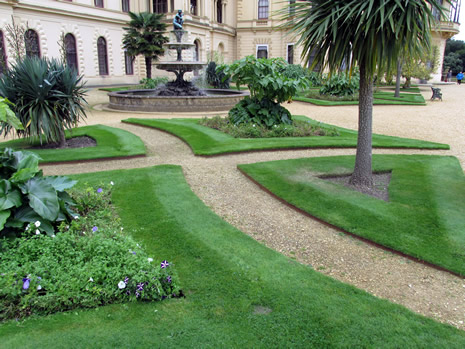 |
||
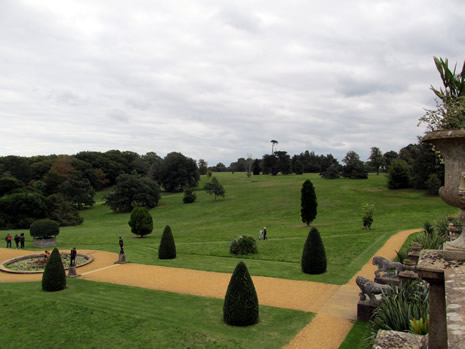 |
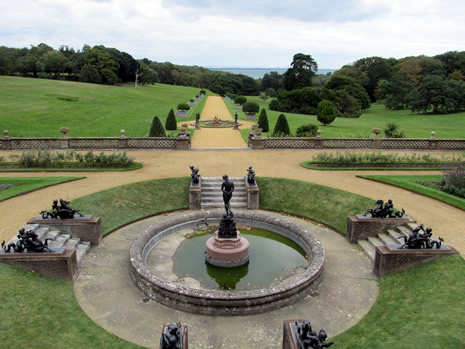 |
|
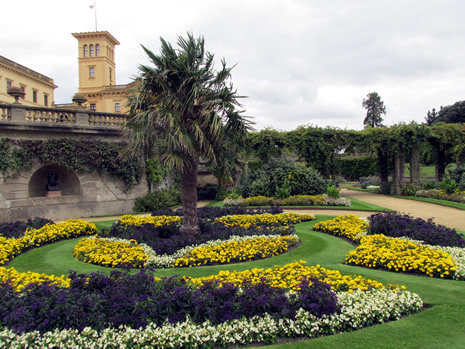 |
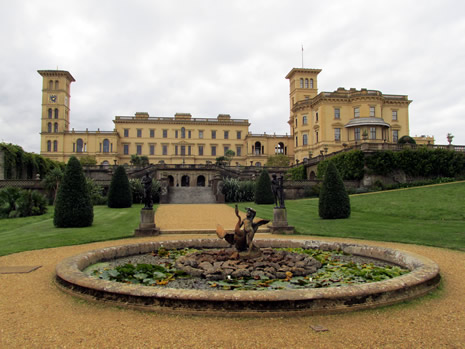 |
Although not exactly in competition with Peterhof in Russia, with respect to fountains (see my separate page here), regarding the arrangement of grand residence and gardens running downhill in the direction of the sea, I found Queen Victoria's residence here both comparable and somewhat reminiscent of an earlier visit to the Tsar's pad just outside St Petersburg.
The Valley Walk
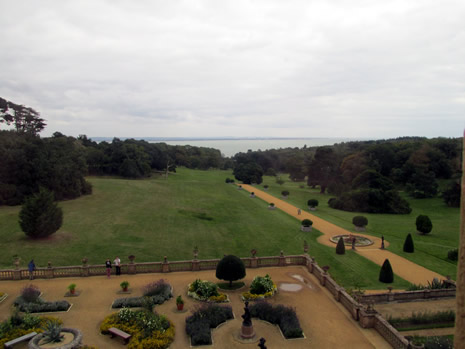 |
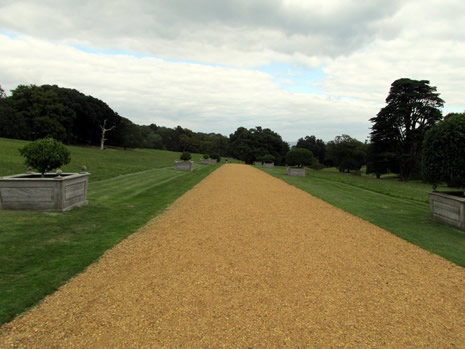 |
|
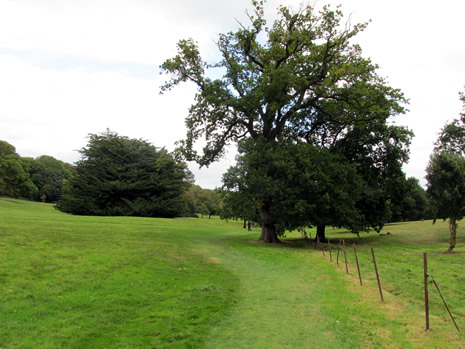 |
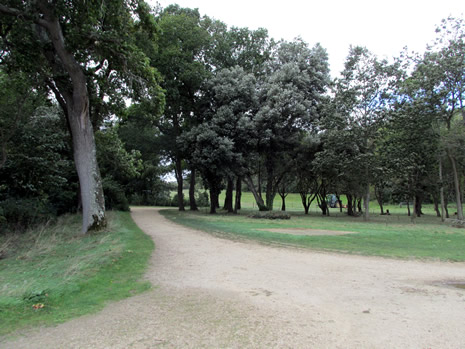 |
The valley footpath (above) leads from the house's terraced gardens down to the beach. Victoria, Albert and the children walked this route most days whilst in residence here and many visitors who would have arrived having landed at the beach would have seen the house for the first time along this route. From 1846-1849, Prince Albert oversaw the planting of trees along this footpath, choosing a mixture of broad-leaved and evergreen species.
Queen Victoria's Beach
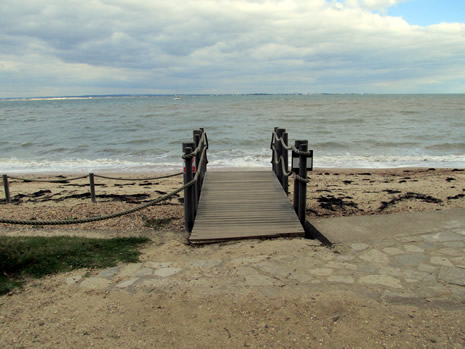 |
 |
|
 |
 |
"Walked down to the beach and played about with the children... The country was looking so lovely and the sea so blue" wrote Victoria in 1845. The Queen regularly came to the estate's beach (above) to bathe and it is here that her children first experienced the seaside and learned to swim. The beach was opened to the public for the first time in July 2012 following an extensive restoration programme, although today, the distant views are somewhat different with the appearance of the likes of Portsmouth's Spinnaker Tower visible on the horizon. Nonetheless, the views from here are magnificent. After walking down from the house, the visitor today may find opportunity to enjoy refreshments available from the café here. Queen Victoria had several alcove seats installed in the grounds at Osborne such as this one here at the beach (bottom left photo) which was constructed (1865-1869) of limestone and decorated inside with blue Minton Tiles. Like most aristocratic ladies in the 19th century, Queen Victoria used a bathing machine when swimming. Her bathing machine (bottom right photo, left) was installed at Osborne in 1864 and includes a verandah at the front from which hung curtains to conceal her as she entered the water, a changing room inside and also a plumbed-in WC. Left undisturbed for a large number of years, the beach and shallow waters of the bay are now important wildlife habitats.
The Swiss Cottage
Prince Albert grew up in Germany with his brother Ernest and influenced by his happy memories, within the grounds at Osborne the royal couple had a Swiss-style chalet, garden plots, a miniature fort and a museum built. Here, Prince Albert recreated his happy childhood world of adventure for his own children to enjoy. Once the garden plots had been laid, work began on the Swiss Cottage in 1853. The children loved Swiss Cottage and many of them brought back their own children to come and play here too. Queen Victoria also continued to use the Swiss-chalet style cottage long after her children had grown up. The thumbnail gallery below shows some photos from the exterior and interior of the Swiss Cottage:
The interior of the Swiss Cottage today includes a hands-on family 'Childhood at Osborne' exhibition where both young and old can learn all about the royal children and their world. Mr and Mrs Warne were the cottage caretakers and they lived in three of the rooms which are now used for the exhibition. Inside the chalet, there are also furnished rooms (including child-sized furniture) which are laid out to illustrate how it would have appeared the last time all of the royal family gathered here in the summer of 1861. The children learnt skills here, such as cooking. Adjacent to the chalet is the Swiss Cottage Garden, where the princes and princesses each had their own plots where they learnt gardening and grew flowers and vegetables using their own miniature gardening tools. The Swiss Cottage and it's interior, as well as the museum and gazelle house (see below), have been carefully brought back to life thanks to funding from many donors and organisations, including the Heritage Lottery Fund.
The Museum
Next to the Swiss Cottage, the museum was also built in Swiss-chalet style. It was planned by Albert, but not built until shortly after his death in 1862. The thumbnail gallery below shows some photos from the exterior and interior of the museum:
Inside the museum is a bewildering eclectic array of objects from the Royal Collection which come from around the world. The royal children were keen collectors, and until the museum was built, had already filled up a room in the Swiss Cottage. In particular, they collected natural history specimens, fossils and antiquities, for example old figurines. Other pieces include a piece of wood from the coffin of George Washington and the first transatlantic telegraph message. For the individual interested in looking at the museum's many curios on display in detail, allow ample time.
The Gazelle House
The Gazelle House (below, left), was named after a family of gazelles that were brought to live here in the 1860's. This wooden shed once housed some of the royal children's pets. The children kept various animals including ducks, chickens, a racoon, donkey and nearby in a hutch, Beatrice kept angora rabbits. A gazelle was born here in 1865 in the original gazelle house which was replaced on the same spot in 1872 by the present building which today serves as a cake shop.
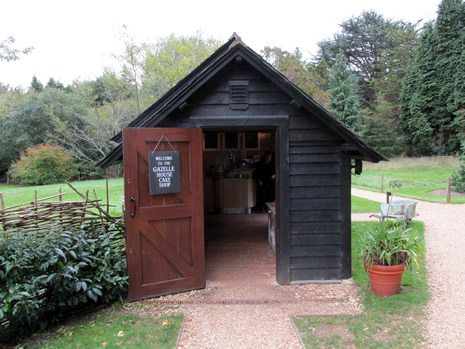 |
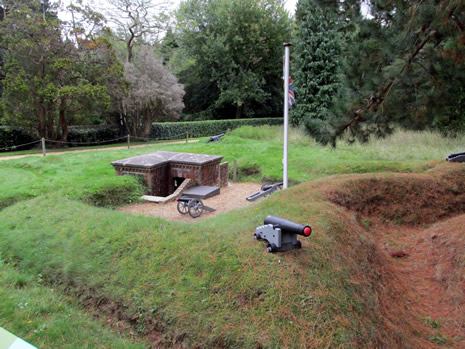 |
Victoria Fort and Albert Barracks
The Victoria Fort and Albert Barracks (above, right) was built in 1856 with the help of Bertie and Alfred as a birthday surprise for their mother, Queen Victoria. The young princes played here, acting out battles with their toy soldiers. The design is a little old-fashioned for the time, but similar to forts from the Crimean War. Miniature barracks were added later by Arthur and Alfred in 1860.
The Rhododendron Walk
 |
 |
 |
 |
|||
 |
 |
 |
The Rhododendron Walk (above) is a path connecting the Swiss Cottage and the beach was frequently used by the children who enjoyed playing outdoors. Prince Albert planted some of the trees in the woods surrounding this path which is lined by rhododendrons. Many different animals live here and some of these are represented today by a number of wooden carvings, as seen in the photos above. For the reader who has an interest in wooden carvings, some more photos are on a separate page on this website, and these pictures were taken at another Royal Estate, Sandringham in Norfolk (link to page Here).
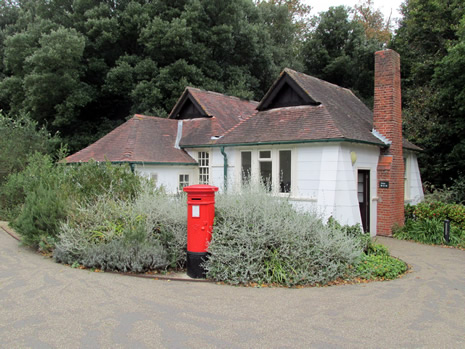 |
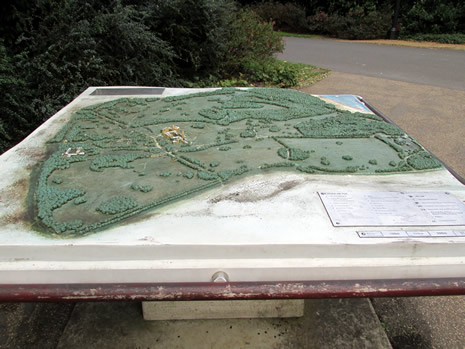 |
Above: Near the main entrance/exit to the house and grounds stands a Victorian post-box (in use) which was donated to English Heritage by The Royal Mail to commemorate the Centenary Celebrations of Queen Victoria's 1897 Diamond Jubilee and just inside the main entrance/exit, an informative relief map depicts a scale layout of the grounds. At the time of this visit (2016), the admission price of £15 for a standard adult ticket at first seemed a little steep, but after realising the scale of the house and grounds and the time required to walk around (not included on this web page are the Ice House, Reservoir and Walled Fruit and Flower Garden), it seemed a reasonable amount. For the less able bodied visitor, seasonal buses connect the house with the main entrance, the beach and Swiss Cottage.
References and Further Reading
1. In Situ Information Boards
2. Osborne House
on Wikipedia
Here
3. English Heritage Website
Here
4. Explore The Royal
Collection at Osborne House
Here
Back to Top